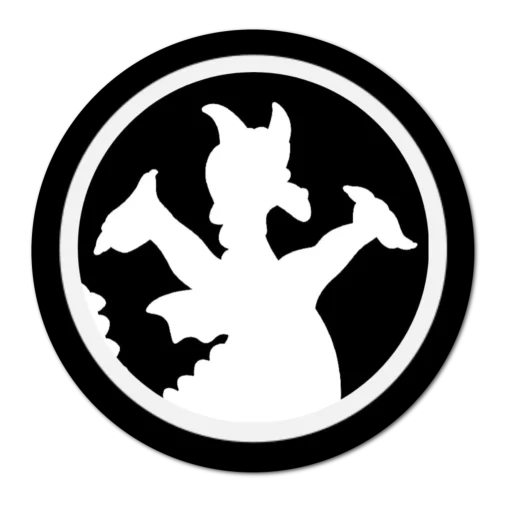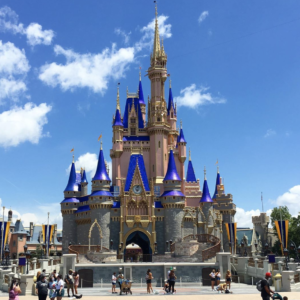(A version of this article was shared with Laughing Place and published on May 16, 2024.)
The iconography of 1950s American television has been burned into the eyes of pop culture for over half a century. The classic imagery of the working dad, homemaking housewife, two kids and a dog, and suburban home with a perfectly manicured lawn have featured prominently in shows like Leave It to Beaver, I Love Lucy, and The Adventures of Ozzie and Harriet. These shows all portrayed women in the cliché role of a stay-at-home housewife or mom.
But if you ask Pam Burns-Clair to describe her mother, she’ll tell you that Disney Legend Harriet Burns was not your typical 1950s housewife. This artistic powerhouse had the talent, the style, and the drive to buck the stereotypical depiction of mid-century American women. A pioneer of Disney Imagineering – Harriet was as comfortable working a band saw as she was in a skirt and high heels. For this edition of Disney Legends Spotlight, let’s celebrate Harriet Burns – Walt Disney Imagineering’s “First Lady.”
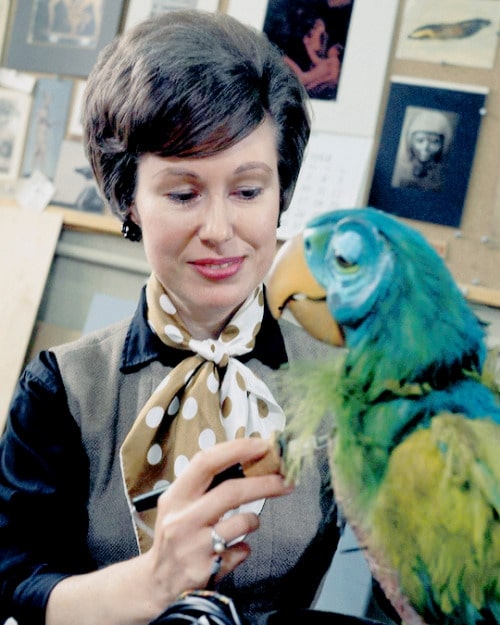
Growing Up Deep in the Heart of Texas
Harriet Tapp was born August 20, 1928 in San Antonio, Texas, and raised in the nearby suburb of Seguin. A Great Depression-era child, Harriet had to be creative and make things to play with. At an early age, Harriet was creating things – a skill that would serve her well over the course of her career. When the smart southerner graduated high school, her father told her he would only pay for her college education if she majored in Home Economics. She agreed, but shortly after entering Southern Methodist University in Dallas, she changed her major to art! Harriet earned her bachelor’s degree from SMU, and continued on to study advanced design at the University of New Mexico.
In 1951, Harriet married her childhood sweetheart Bill Burns. The couple welcomed their baby girl Pam in 1952, and moved out west to Los Angeles the following year to pursue Bill’s dream of being an actor.
Painting the Golden Coast
When immediate success eluded her husband, Harriet decided to look for work herself. With previous experience working on store displays for Neiman Marcus in Texas, Harriet found a part-time position with DICE (Display Industries Cooperative Exchange). Working for DICE, Harriet made props for television shows like The Colgate Comedy Hour, and sets for floor shows at Las Vegas hotels, including The Dunes Hotel and Country Club (later replaced with Bellagio).
While working with DICE, Harriet also chipped in on the creation of a whimsical Southern California tourist destination called Santa’s Village. But when DICE went out of business before the park was completed, Harriet found herself without a job. One of Harriet’s coworkers who had once worked at Walt Disney Studios returned to the company, and suggested she head there too. In what would prove to be the most significant moment in her professional career, Harriet was hired by Disney to paint sets and props for the new Mickey Mouse Club television show.
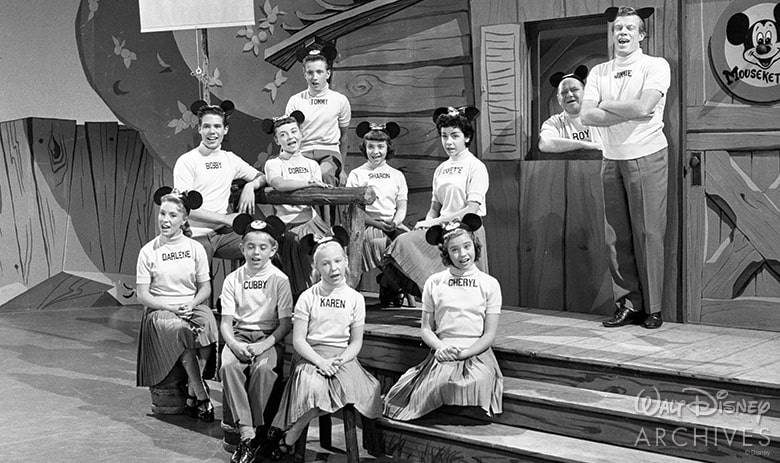
Moving Up the Disney Ladder
It is safe to say that upon first hiring Harriet Burns, the Disney Studios didn’t realize what a special person they had brought onboard. Harriet excelled at her position, and quickly (as in, a matter of weeks) moved beyond set painting, to coordinating the show’s color styling, even designing and the famous “Mouse Clubhouse.”
When Walt Disney himself learned of Harriet’s industrial know-how, he quickly brought her into his dream project – Disneyland. With the park opening in less than a year and still so much to be done, Walt needed all the help he could get! Harriet shared a workstation at the Disney Studios with fellow Disney employee (and fellow Disney Legend) Fred Joerger. While Joerger was working on prototype models for Disneyland, Harriet began working with him in Disney’s model shop, building miniature prototypes of Disneyland buildings and attractions. Together – along with another fellow Disney Legend Wathel Rogers the trio comprised the original WED Model Shop – a division of WED Enterprises (now known as Walt Disney Imagineering). Harriet fondly remembered those early days with Rogers and Joerger, musing “We just helped each other, and it was a good team because each overlapped in talent.”
A Standout in the Disney Studios
Harriet Burns stood out at the Disney Studios, not just because she was one of very few women working in a male-dominated field, but also because of her sense of high fashion. Whether working in the studios or on the sets, Harriet arrived each day wearing a skirt and high-heel shoes. While dressed to the nines, Harriet could work a lathe, saw, or drill press as well as any man at the Studios.
“It was the 1950s,” Harriet later explained. “I wore color-coordinated dresses, high heels, and gloves to work. Girls didn’t wear slacks back then, although I carried a pair in a little sack, just in case I had to climb into high places.”
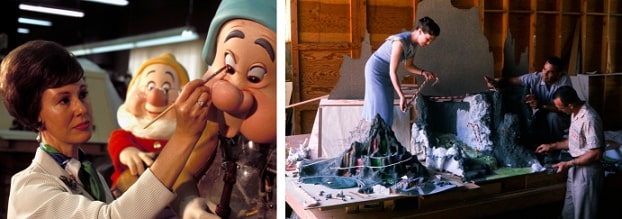
“She could do everything a man could do,” said Disney Legend Marty Sklar, former executive vice president of Walt Disney Parks and Resorts and a contemporary of Harriet. “She was a fabulous artist. She had a wonderful sense of color and design. And she was the best-dressed. That never changed.”
Sklar went on to note how Harriet was often the center of attention at the studios. “The true heartbeat of the Imagineering model shop was a little corner where the Queen Bee held court. No matter what time of day, you could find the big boys – even Walt – buzzing around Harriet.”
Despite her perfectly proper appearance, Harriet was never afraid to mix it up with the guys in the studios. She could hold her own in any conversation, ranging from the creative to the technical, with a healthy amount of raunchy humor thrown in just to blow off some steam.
On the Air With Walt Disney
Walt Disney himself had an immense respect for Harriet Burns. Back when she was the only woman at the studio, surrounded by men, Walt committed to building her a private bathroom so she wouldn’t have to share the men’s room (there was no women’s room in the early days of the studio).
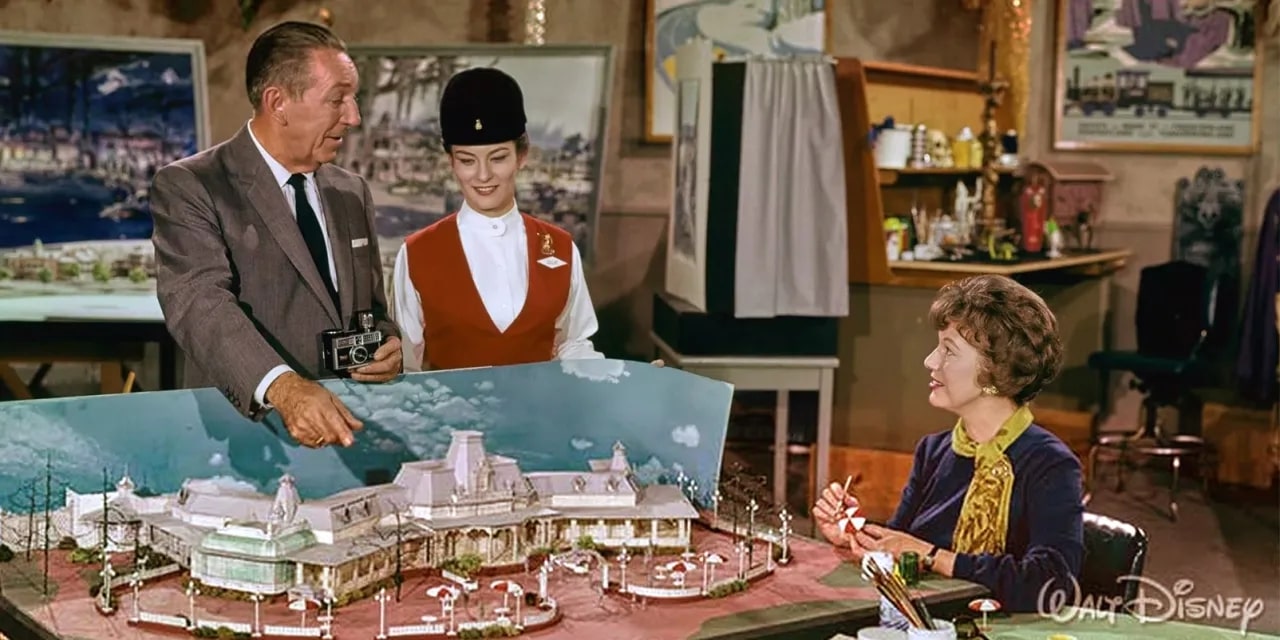
Walt’s admiration for Harriet translated into television appearances as well. Fans of Walt’s classic television appearances may recognize Harriet Burns on the small screen. On occasion, when Walt would introduce new theme park attractions to television audiences through Walt Disney’s Wonderful World of Color, Harriet would occasionally show up as one of his the top designers to show off his latest and greatest creations. In addition to her incredible design work, Harriet would present extremely well on television. Her elegance and formal dress provided an excellent on-screen compliment to Walt himself.
Designing Disneyland
One of Harriet’s first assignments with WED was to work on a model of what would be the landmark of Disneyland – Sleeping Beauty Castle. After only a few months with the company, Harriet Burns already had her fingerprints on this Disney Parks icon!
Once Disneyland was open and continuing to evolve, Harriet continued to contribute. Let’s admire a few of her most notable contributions.
Tiny Treasures in Disneyland’s Storybook Land
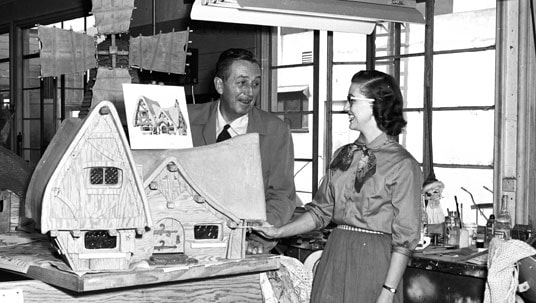
An expert in miniatures and the design of dioramas, Harriet was the major creator behind the Storybook Land Canal Boats, which originally opened as Canal Boats of the World. One of the sweetest attractions in Disneyland, the Canal Boats float guests by a series of miniature recreations of favorite Disney film scenes, including Gepetto’s village from Pinocchio, the Pigs’ houses from Three Little Pigs, the Kensington Gardens from Peter Pan, Alice’s cottage from Alice in Wonderland, the Old Mill from the 1937 Silly Symphony cartoon of the same name, Toad Hall from The Wind in the Willows, the diamond mine from Snow White and the Seven Dwarfs, and even Cinderella’s Castle.
Over the years, several of the original scenes have been replaced, while others have been added. But Harriet Burns was the master creator of the original ride scenes.
Miniature Matterhorn
Only a few short years after Disneyland opened, the park underwent a major expansion, located within the park’s Tomorrowland section. Three major attractions were added, including Matterhorn Bobsleds, the Disneyland Monorail, and Submarine Voyage.
For Matterhorn Bobsleds, Harriet created the original 1/100 scale model of Walt Disney’s “holey mountain,” setting the stage for fellow Disney Legend Bob Gurr to wind those famous rails throughout the historic attraction.
Harriet also provided finishing touches to many of the set pieces to Submarine Voyage. This task proved challenging, with many of the props resided within chlorinated water, while others stood steadfast above water, in the beating sunlight. Nonetheless, she always rose to the challenge.
Down in New Orleans
New Orleans Square – the first new “land” added to Disneyland since opening day in 1955, opened in July 1966. Harriet was included in the design of this expansion, which Walt once joked “cost as much as the original Louisiana Purchase.”
Disney’s Haunted Mansion
The most famous building in Disneyland’s New Orleans Square is the Haunted Mansion, which opened in August 1969 (though the Mansion façade was in place years earlier). Harriet Burns’ contributions to this Disney Parks icon led to her being recognized in Walt Disney World’s version of the Haunted Mansion in Magic Kingdom’s Liberty Square, with a tombstone reading:
“First lady of the opera
Our haunting Harriet
Searched for a tune
But never could carry it”
Pirates of the Caribbean
Also located in New Orleans Square is another fan favorite attraction – Pirates of the Caribbean. In the earlier stages of development, Harriet Burns built a model of the entire dark ride, which laid the groundwork for the full designs to follow. She was also a figure finisher on some of the pirate mannequins. Harriet’s granddaughter Chelsea Clair fondly remembers one of her grandmother’s stories from the WED Model Shop, where Harriet admitted that she “modeled the pirate (who sits on the bridge) after the family Milk Man!”
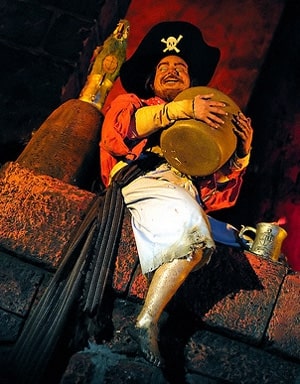
In the Tiki, Tiki, Tiki, Tiki, Tiki Room
Perhaps the most remarkable and memorable of Harriet’s contributions to Disneyland came in the form of “living, breathing” birds. The singing birds of Walt Disney’s Enchanted Tiki Room – the first audio animatronic attraction figures of Disneyland – were the handiwork of Harriet Burns.
But the finished product didn’t come without its growing pains. While trying to realistically animate the birds’ breath, Harriet experienced frustration, noting “When [the birds] breathed out, it would be fine, but when they came back they scrunched. They looked like they had mites.” The persistent Imagineer found a solution to her problem while observing Walt Disney during a planning meeting. Walt’s cashmere sweater exhibited the shape and elasticity Harriet had been looking for, and before long, her birds were living and breathing quite healthily!
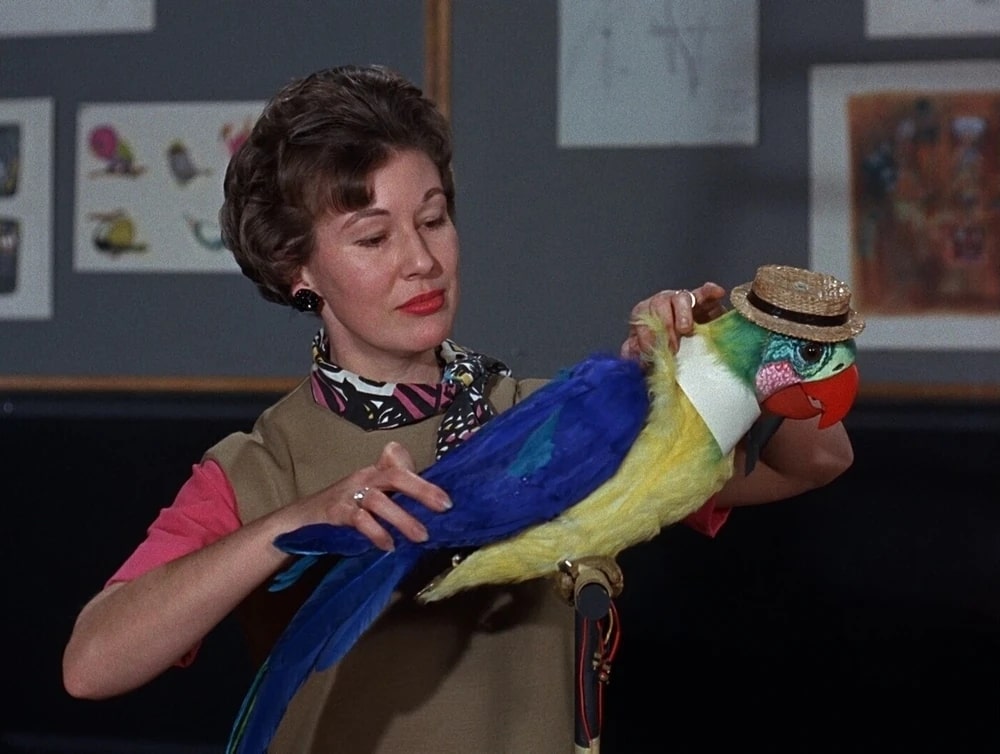
Much like Walt himself, Harriet had the attitude of a perfectionist. “Good enough was not [good enough] for Harriet; it had to be perfect,” said Blaine Gibson, a former animator and sculptor (and yet another Disney Legend) who worked with Harriet and enjoyed a long-lasting friendship with her in their later years.
Speaking of birds – you know that tweeting robin that perches on Mary Poppins’ finger in the 1964 film of the same name? You can thank Harriet Burns.
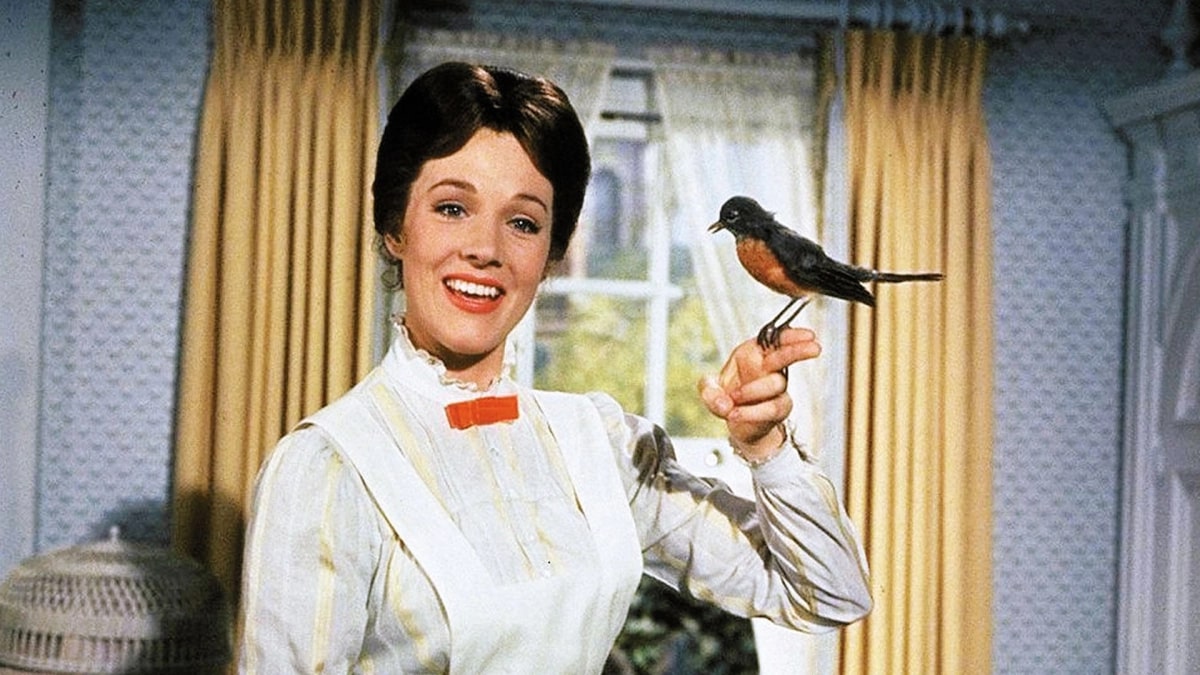
1964 New York World’s Fair
Outside the Disneyland berm, it was all hands on deck in the 12-18 months leading up to the 1964 World’s Fair in New York, with Disney pouring resources into four attractions which would become a proving ground of sorts for iconic Disney attractions to come. Harriet Burns contributed to all of these attractions, which included:
- “it’s a small world” (created for Pepsi Cola)
- Carousel of Progress (created for General Electric)
- Great Moments With Mr. Lincoln (created for the State of Illinois)
- Magic Skyway (created for Ford Motor Company)
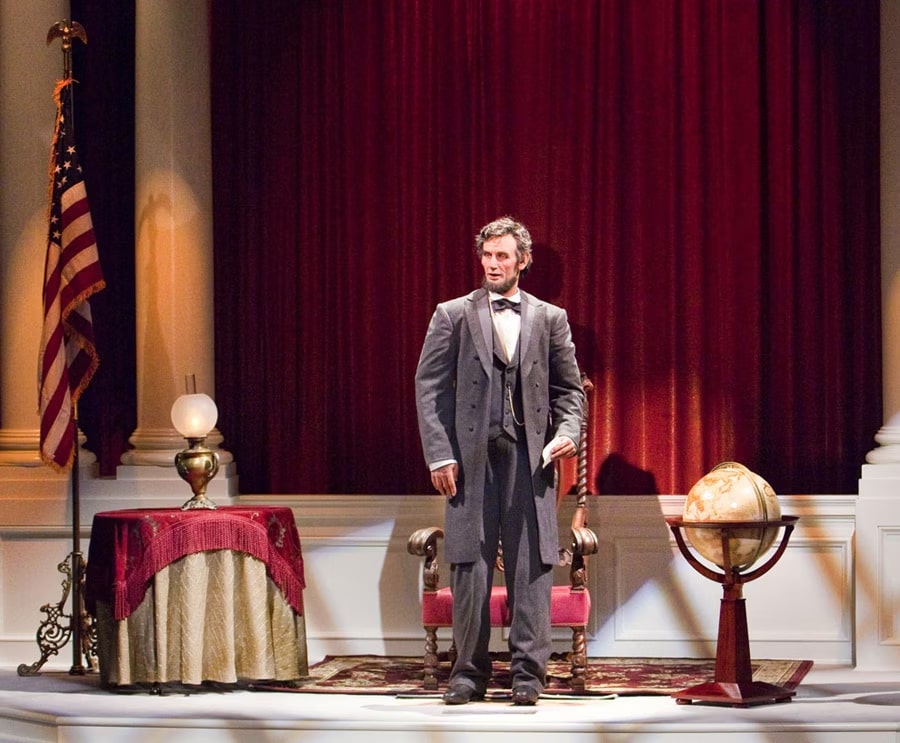
Harriet worked on everything from stage design to figure finishing for the attractions – three of which would settle in Disneyland following the completion of the World’s Fair in 1965. Among the most precious of Harriet’s finishing touches were the faces on countless child figures from “it’s a small world.” Harriet would receive the figures mostly completed, and would add paint and other touches to the figures to make them – as Blaine Gibson would say – “come alive.”
Harriet Burns – An Inspiring Life
After working for the Walt Disney Company for 31 inspiring years, Harriet Burns retired in 1986.
In 1992, she was honored as the first woman to receive a window on Disneyland’s Main Street, U.S.A., reading:
“The
Artisans Loft
Handmade Miniatures
By
Harriet Burns.”

Harriet’s window is located on the Emporium building, near the Fire Department and Walt’s Apartment.
In 2000, Harriet was named a Disney Legend – a well-deserved honor.
Harriet Burns died July 25, 2008 at age 79. After she passed, her family received a jaw-dropping amount of support from so many people Harriet touched in her days at Disney.
I’ll end this article with a quote from Chelsea Clair – granddaughter of Harriet Burns, from a piece she wrote for the Walt Disney Family Museum on March 27, 2012:
“The outpouring of love and stories was overwhelming! I didn’t realize how many lives she touched and how many people loved and respected her! We heard stories of her remarkable talent, her wicked sense of humor and the way she made everyone feel important… Grandma Harriet was a pioneer in so many ways – as a woman working in a man’s world and also as a class act. She was a true Imagineer in life and in Disney, and I will always admire her for that!”
Thanks for reading about Harriet Burns – one of the great women (and one of the greatest Imagineers) – in Disney history.
And a special thanks to Harriet’s daughter, Pam Burns-Clair, for offering additional insight to me via email/messaging and from her recent appearance with her daughter Haley Clair on the Disney Antiquities & Collectibles Podcast.
Offer a comment or share this article with a friend by reaching out on social at: Instagram Facebook X
Check out more Disney Legends in our spotlight collection.
Sources:
Walt Disney’s First Lady of Imagineering, Harriet Burns – Pam Burns-Clair and Don Peri, January 2010
Disney Legend Harriet Burns, D23
First female designer for Walt Disney Imagineering – Mary Rourke, Los Angeles Times, July 30, 2008
The Finishing Touch of Harriet Burns – Walt’s Folly, August 20, 2021
